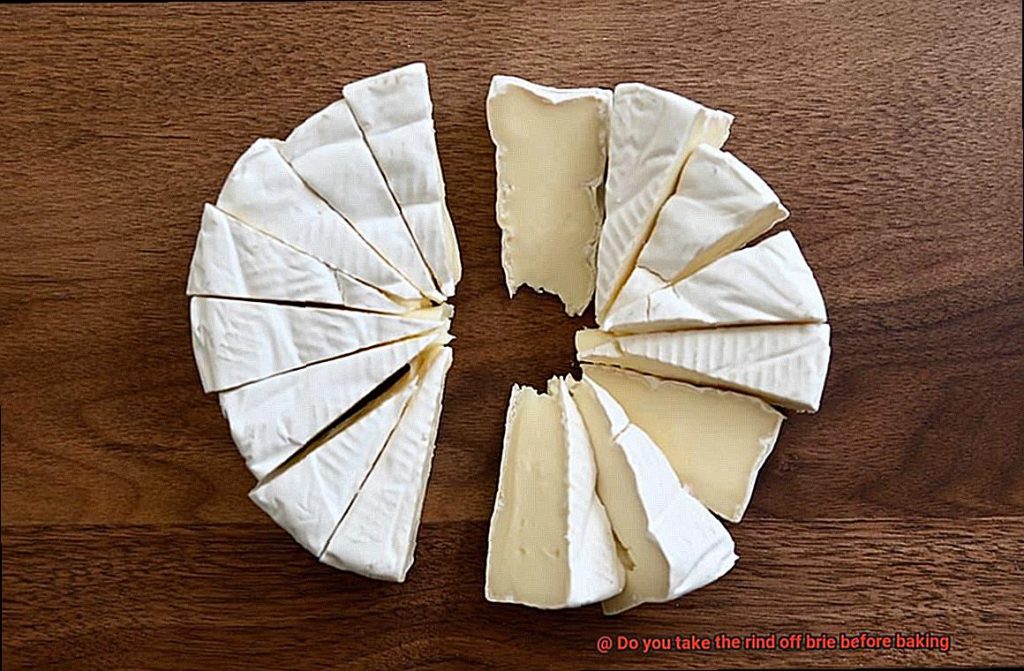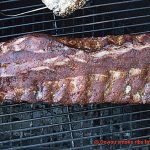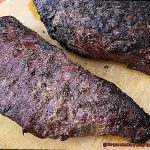Are you feeling perplexed about how to prepare the perfect brie cheese platter for your guests? Don’t worry; we’ve all been there. The question that often arises is, “Do I take the rind off brie before baking?” Well, fear not, because we’re here to help you navigate this culinary conundrum.
Brie cheese is a French soft-ripened cheese made from cow’s milk. It can be enjoyed in various ways, but baking it until it becomes gooey and delicious is undoubtedly a crowd-pleaser. Before we address the question at hand, let’s delve into the purpose of the rind.
The rind of brie cheese is entirely edible and adds a distinctive flavor that cannot be replicated. As the cheese ages, its white mold-covered rind breaks down its proteins, resulting in a softer and creamier texture. Therefore, removing the rind could mean missing out on an authentic brie experience.
However, not all rinds are created equal. If your brie has a thick or tough texture that doesn’t look appetizing, it’s best to remove it before baking. Otherwise, you risk chewing on an unsavory experience that could ruin your otherwise perfect platter.
So what’s the verdict? Do you take the rind off brie before baking? The answer depends on your preference and the type of rind present. In this blog post, we’ll explore different types of brie cheese rinds and whether they should be removed before baking. Get ready to impress your guests with a perfectly baked brie every time.
Contents
What is Brie Cheese?
Brie cheese is a French soft-ripened cheese that has traveled the world and captured the hearts of foodies everywhere. This cheese is typically made from cow’s milk, although it can also be made from goat’s or sheep’s milk. The production process for Brie cheese involves adding rennet to the milk to coagulate it and form curds. The curds are then cut and drained before being placed into molds to form the characteristic round shape. After this, the cheese is left to age for several weeks, during which time the rind develops and the interior softens.
What sets Brie cheese apart is its white, bloomy rind and creamy, slightly tangy interior. Its smooth texture and rich flavor become more intense as it ages. This cheesy delight can be enjoyed on its own or used in various dishes, such as baked Brie or as a topping for crackers or bread.
When it comes to baking Brie cheese, there are differing opinions on whether or not to remove the rind before cooking. Some people prefer to leave the rind on as it helps hold the cheese together while it bakes and adds flavor. Others choose to remove it as they find it too strong or tough. But regardless of your preference, you can avoid a gooey mess in your oven by removing any packaging before baking and following proper heating instructions.
The rind itself adds a unique flavor to the cheese, but if you find it unpleasant, you can easily remove it after baking by using a knife to gently scrape it off.
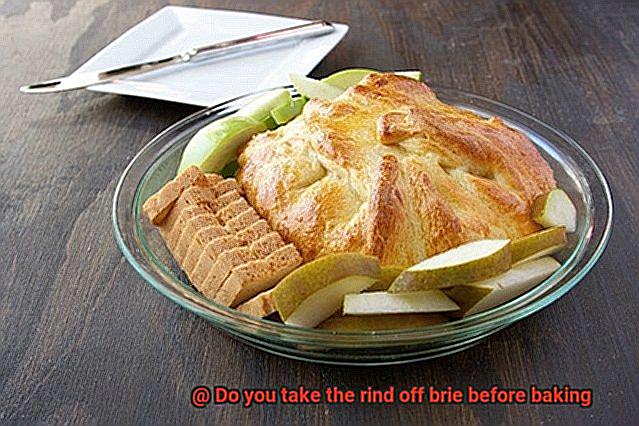
What is the Rind on Brie Cheese?
The rind on Brie cheese is a byproduct of the natural cheese-making process. It emerges as a protective layer for the soft and delicate cheese inside when Penicillium candidum, a type of mold, develops on the surface during aging. This mold not only safeguards the cheese but also contributes to its flavor and texture, making it an integral part of the cheese.
Now, here’s the exciting part – you can eat the rind. It’s safe to consume and adds to the overall taste experience of Brie. However, if you prefer to remove it before eating, that’s alright too.
The taste and texture of the rind vary depending on the age of the cheese. Younger cheeses have a milder flavor and softer rind while older cheeses have a stronger flavor and firmer rind. So, if you’re looking for a more piquant taste, go for an aged cheese with a more developed rind.
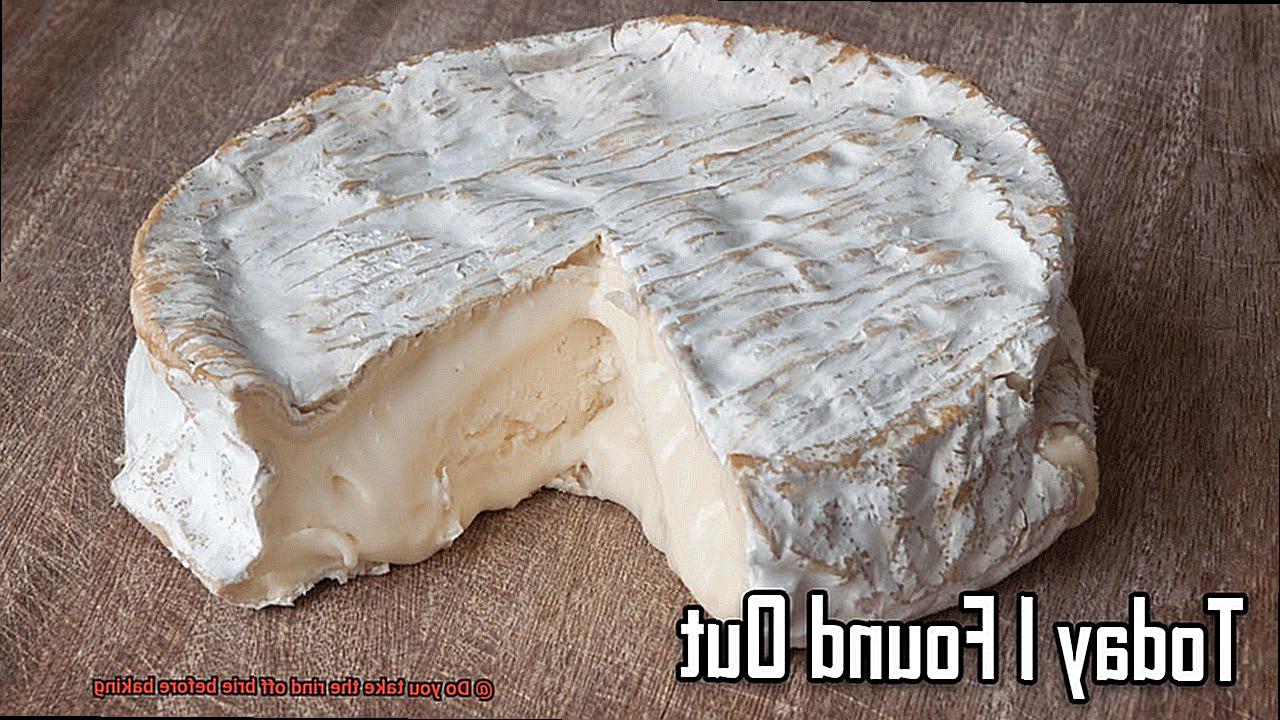
When it comes to cooking with Brie cheese, there’s no need to remove the rind before baking. In fact, leaving it on can help hold the cheese together during baking and add an extra layer of flavor and texture to your dish.
Should You Remove the Rind Before Baking?
When it comes to baking brie, one of the most common questions people have is whether or not to remove the rind before baking. As an expert on the matter, I’m here to provide you with all the information you need to make an informed decision.
First and foremost, let’s address the age-old debate – should you remove the rind before baking? The short answer is no. The rind on brie is completely edible and can add a delicious earthy flavor to your baked brie dish. In fact, leaving the rind on can enhance the overall taste and texture of your dish. Not only that, but it can also help hold the cheese together as it bakes, preventing it from oozing too much.
But, of course, personal taste preferences play a significant role in this decision. Some people may find the rind too tough or chewy for their liking and choose to remove it. This can affect the texture and overall appearance of your baked brie, so it’s important to keep that in mind when making your decision.
Let’s break down the pros and cons of leaving the rind on:
Pros:
- Adds flavor: The rind can provide an earthy flavor that complements the cheese nicely.
- Holds cheese together: The rind acts as a casing that helps keep the cheese from oozing out too much.
- Easy preparation: Leaving the rind on eliminates the need for extra preparation time and makes for a quick and easy way to bake your brie.
Cons:
- Personal preference: If you don’t like the taste or texture of the rind, then it’s best to remove it.
- Tough or chewy: If you find the rind too tough or chewy, then it may affect the overall texture of your baked brie.
- Appearance: Removing the rind can affect the appearance of your baked brie and may not look as aesthetically pleasing.
Benefits of Leaving the Rind On
Not only does it simplify the preparation process, but it also enhances the flavor and texture of the cheese, as well as creates a visually appealing dish.
Let’s start with texture – the rind helps hold the cheese together, preventing it from melting too quickly. This means you’ll avoid the dreaded runny mess and instead enjoy a perfectly textured brie. Plus, when baked, the rind becomes slightly crispy, adding an extra layer of texture to the cheese.
But what about flavor? The rind has a slightly nutty and earthy taste that perfectly complements the creamy texture of brie. By leaving it on, you’ll add an extra layer of depth to your dish that will leave your taste buds singing.
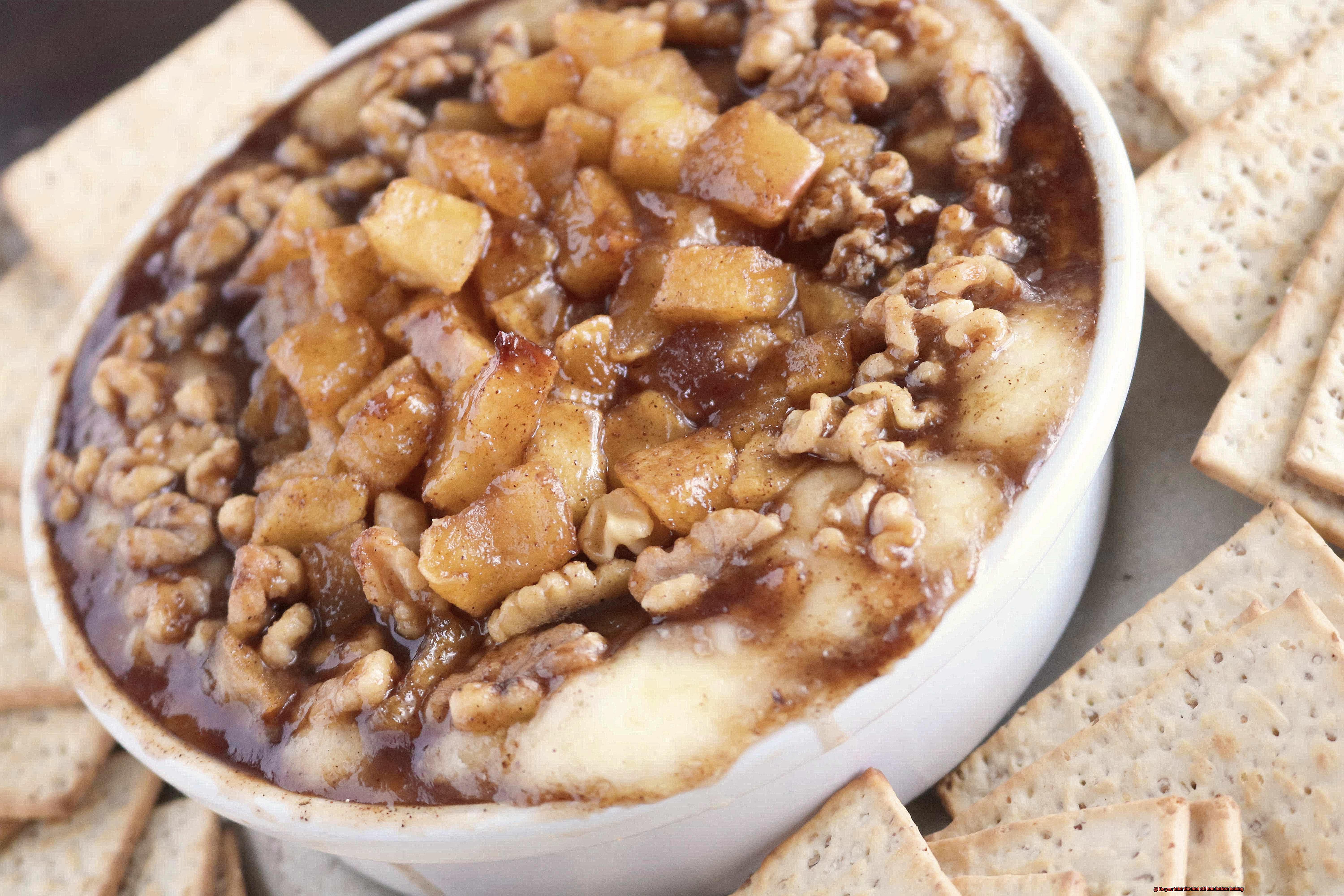
And let’s not forget about presentation – leaving the rind on creates a gorgeous contrast between the creamy center and golden rind. Your guests will be impressed before they even take a bite.
Finally, removing the rind can be a tedious and time-consuming task. By leaving it on, you simplify the preparation process and can enjoy your baked brie without any additional hassle.
How to Remove the Rind After Baking
Indulging in a perfectly baked Brie is a delightful experience. However, some people prefer to remove the rind for a smoother taste and texture. If you’re one of them, fret not. Removing the rind after baking is simple with these helpful tips.
Let it cool
After baking the Brie, let it cool for a few minutes before attempting to remove the rind. This will prevent burning your fingers and also give the cheese time to set.
Score it
Using a sharp knife, score around the edge of the cheese where the rind meets the soft cheese. Be careful not to cut too deeply into the cheese itself.
Scoring is not necessary, but it will make removing the rind easier and less messy.
Peel it away
Once you have scored around the entire edge, use your fingers or a small knife to carefully peel away the rind. The rind should come off easily and in one piece.
Be gentle while peeling, so you don’t end up removing too much of the soft cheese underneath.
Be vigilant
If you encounter any resistance, use your knife to gently separate any stubborn areas of rind from the cheese. However, be careful not to remove too much of the soft cheese in the process.
Enjoy.
After removing all of the rind, your baked Brie is ready to be served. You can either serve it as it is or add additional toppings like fruit preserves, nuts, or honey.
One important thing to remember is that baked Brie is best served warm but not hot as it can cause burns.
Heating Instructions for Best Results
Before you fire up the oven, it’s essential to know the heating instructions for best results.
First, preheat your oven to 350°F and line a baking sheet with parchment paper. Now, the age-old question: rind on or off? The choice is yours, but if you decide to keep the rind on, make sure to score the top of the brie with a knife. This will ensure an even melt and prevent any messy explosions.
For added flavor, consider drizzling some olive oil or honey on top of the brie before popping it in the oven. Bake for 15-20 minutes or until melted in the center. For larger wheels of brie, adjust the baking time accordingly.
If you prefer a smoother melt, carefully remove the top layer of rind with a sharp knife. Don’t cut too deep into the cheese itself, though. The remaining rind can be sliced off after baking.
Once your baked brie is done, let it cool for a few minutes before serving. And don’t forget to dress it up with your favorite toppings. Try fig jam and toasted nuts or roasted garlic and fresh herbs for a savory twist. Or go sweet with caramelized onions and apples or maple syrup and bacon bits.
Personal Preference: To Eat or Not to Eat the Rind?
As an expert on this topic, I’ve delved into the matter and found that it all boils down to personal preference.
For those who opt to eat the rind, they relish the earthy and slightly bitter flavor that it adds to brie. The rind also provides a range of flavors and textures that enhance the complexity of the cheese. Moreover, it functions as a protective layer that helps keep the cheese moist and flavorsome.
However, some individuals find the texture of the rind too tough or waxy and choose to remove it before eating the cheese. Furthermore, if not stored correctly or left for too long, the rind may develop an off-putting flavor or odor that can compromise the taste of the cheese.
Ultimately, the decision lies with you – whether to eat or not to eat the rind. If you’re unsure, why not try both with and without the rind to see which taste you prefer? Experiment with various toppings and pairings as well – brie is a versatile cheese that can be enjoyed in numerous ways.
yyU21aGYVBQ” >
Conclusion
To sum up, the decision to remove the rind from brie before baking is a personal choice. The rind is completely edible and provides a distinctive flavor that cannot be replicated. By removing it, you may miss out on an authentic brie experience. However, not all rinds are created equal, so if your brie has a thick or tough texture that doesn’t seem appealing, it’s best to take it off before baking.
Leaving the rind on can enhance the overall taste and texture of your baked brie dish. It can help hold the cheese together as it cooks, preventing excessive oozing. Additionally, when baked, the rind becomes slightly crispy, adding another dimension of texture to the cheese.
If you opt to remove the rind after baking, let the cheese cool for a few minutes first before gently peeling it away. Be careful while removing it so as not to take too much of the soft cheese underneath.
Ultimately, whether you choose to eat or discard the rind is entirely up to you. Brie is a versatile cheese that can be enjoyed in numerous ways with various toppings and pairings.

